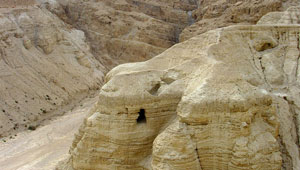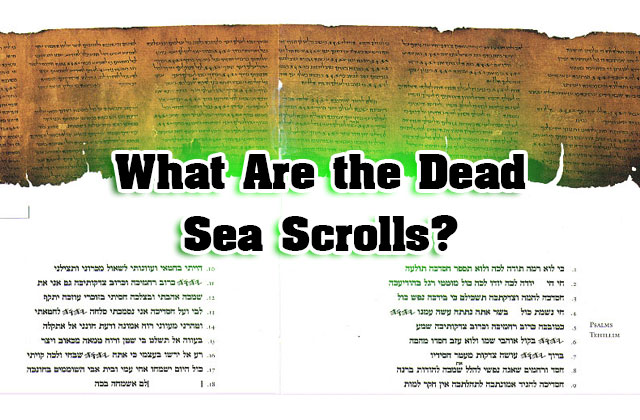The Dead Sea Scrolls are bits of parchments – and a few complete scrolls – that were found near the Dead Sea. They became quite popular in the media after their discovery, and many people still find them fascinating. While there are some things we know about them, there is much that is still speculation.
The origin of the scrolls is not certain. The original assumption was that they were copies made by Essenes living in the town near where they were found. While it is likely that at least some were copied there, based on both the storage containers and the fact that a room was found that appeared to be used for copying, it is unlikely that all were. There were several different hands represented and a variety of literature types.
The scrolls and fragments contained texts both from the Bible (the book of Isaiah is the most notable of these, and all books except Esther are represented) and secular (the prime example of these is the community rules document). Also included are commentaries, paraphrases discussing the Mosaic Law, community rule books, conduct for war, psalms of thanksgiving (including some attributed to King David and Joshua that are not included in the Bible), hymn-like compositions, liturgy-related texts, and wise writings, among others. While not all have been translated yet, many have.
One of the more interesting finds is known as the Copper Scroll, which appears to be a map of 64 hiding places for precious things such as gold, silver, herbs, and manuscripts; however, none of these have been found, as yet. It was discovered in the third cave.

Another, the Book of War, gives details of a final battle between the Sons of Light and the Sons of Darkness. While some call it prophetic and compare it with the Biblical book of Revelation, others consider it to be a work of fiction. Some believe that another fragment, The War of the Messiah, is the ending of this manuscript.
A few of the scrolls contain stories about ancient Bible figures such as Abraham (including an explanation about God’s request to Abraham to sacrifice his son Isaac), Noah, and Enoch (Noah’s father).
Preserved for a thousand years or more, the scrolls were discovered inside the caves near Khirbet Qumran by three young Bedouin goat herders in 1947. The first to find them, Juma, told his cousins, and his younger cousin Muhammed beat him to the cave the next morning. The three were disappointed that the pottery contained no treasure; they were unaware until later of the historical treasure they had uncovered. Only seven of the scrolls were found in that first cave. Over the following decade, more Bedouins explored the area and discovered ten more caves that contained texts.
For about fifty years after their discovery, the only people who had access to the Dead Sea Scrolls were the small group of scholars who were chosen by the Jordanian Department of Antiquities. Some believed it was taking too long for the documents to be published. In 1991, a group of researchers created a computer program for the reconstruction of an unpublished text to which they had access, and they and other researchers were subsequently granted access to the photographs of the scrolls. In 2011, Google and the Israel Museum (where the Scrolls were kept) collaborated to publish five of the scrolls online.
More than 800 manuscripts are represented among the scrolls and fragments. Over 15,000 fragments were found – most of them in the fourth cave discovered. The documents are written mostly in Hebrew, but some are in Aramaic instead, and a few are in Greek. While Hebrew was the primary language of Israel for most of BC history, toward the end of the BC era and into the beginning of the AD centuries, Aramaic was the more common language. They are mostly made of animal skins, but some are papyrus, and the one is of copper. The ink used is carbon-based.
The purpose of the storage of the scrolls in these caves is a matter of speculation. Some believe that the caves were used as a repository for the scrolls that contained errors due to mistakes by the scribes in copying. Because texts were more precious (especially Biblical texts), these people believe that they were stored rather than destroyed.
An alternate belief is that the caves functioned as a library for a sect of Jews, either as is, or hidden to protect the texts from the Romans when they came to put down a Jewish revolt around 70 AD. This sect was known as the Essenes, who were mentioned by Josephus in his historical manuscripts, though not in the Bible. Interestingly, even though the community of Qumran was already formed when Jesus was preaching, the Scrolls do not mention Him or His followers that are mentioned in the Bible.
Either way, the Scrolls have some merit for today’s scholars through their historical perspective. For religious individuals, the Scrolls offer increased understanding of the beliefs and practices followed by Jews and early Christians. They include previously unseen books and psalms, as well. Some of them give a look into the period between the Old Testament and the New Testament, that spans approximately 400 years. There is a lot of discussion around the authenticity of some of the scrolls from a Christian Biblical perspective.
Secular people can also find value in the manuscripts. A study of ancient Hebrew writing exhibited in the fragments will find a variety of samples to analyze, and the texts about the community and other non-Biblical texts can offer a fresh insight into the Jewish culture of the time period.
While there are still many questions about the Dead Sea Scrolls among individuals and scholars, it cannot be denied that the Scrolls are an incredible discovery, with historical value.

